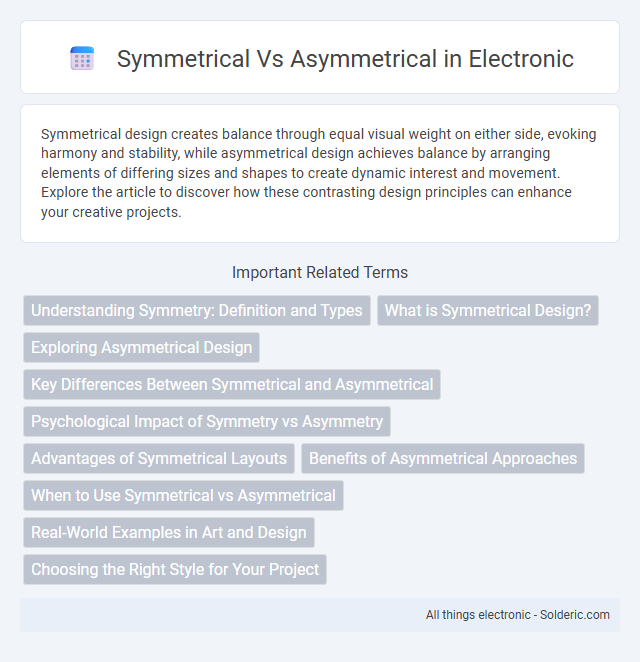Symmetrical design creates balance through equal visual weight on either side, evoking harmony and stability, while asymmetrical design achieves balance by arranging elements of differing sizes and shapes to create dynamic interest and movement. Explore the article to discover how these contrasting design principles can enhance your creative projects.
Comparison Table
| Feature | Symmetrical | Asymmetrical |
|---|---|---|
| Definition | Balanced design with mirrored elements | Unbalanced design with non-mirrored elements |
| Visual Impact | Stable, formal, predictable | Dynamic, interesting, tension |
| Use Cases | Corporate branding, formal layouts | Creative designs, modern interfaces |
| Balance Type | Equal weight distribution | Unequal weight distribution |
| Common Shapes | Circles, squares, mirrored patterns | Irregular shapes, varied sizes |
| Examples | Human face, butterfly wings | Asymmetrical logos, abstract art |
Understanding Symmetry: Definition and Types
Symmetry refers to the balanced arrangement of elements on either side of a central axis, creating visual harmony. Symmetrical designs feature mirrored or identical parts, while asymmetrical compositions rely on unequal yet balanced elements to generate interest and dynamism. Recognizing the types of symmetry--reflective, rotational, and translational--enhances comprehension of how symmetry influences aesthetics and structure in various fields.
What is Symmetrical Design?
Symmetrical design features balanced elements on either side of a central axis, creating harmony and visual stability. This design approach often uses identical or mirrored shapes, colors, and patterns to evoke a sense of order and calm. Your projects benefit from symmetrical design by providing clarity and structure that appeal to viewers seeking cohesive and organized visuals.
Exploring Asymmetrical Design
Asymmetrical design creates visual interest by balancing elements of different sizes, shapes, or colors without mirroring each other, resulting in a dynamic composition. This approach encourages a more natural and engaging layout that guides Your eye across the design, enhancing user experience and attention retention. By leveraging asymmetry, designers can break monotony and foster creativity, making their work stand out in competitive visual environments.
Key Differences Between Symmetrical and Asymmetrical
Symmetrical designs feature balanced elements that mirror each other on either side, creating harmony and stability, while asymmetrical designs rely on uneven visual weight to achieve dynamic interest and movement. Symmetrical compositions often convey formality and order, making them ideal for corporate branding, whereas asymmetrical layouts evoke creativity and modernity, suited for artistic and innovative projects. Your choice between symmetrical and asymmetrical depends on the desired emotional impact and message clarity in your design work.
Psychological Impact of Symmetry vs Asymmetry
Symmetry in design often evokes feelings of balance, stability, and calmness, promoting a sense of order and predictability in the viewer's mind. In contrast, asymmetry introduces dynamism and tension, stimulating curiosity and engagement by challenging visual expectations. Psychological studies reveal that symmetrical compositions tend to enhance perceptions of beauty and trustworthiness, while asymmetrical layouts can evoke excitement and creativity.
Advantages of Symmetrical Layouts
Symmetrical layouts offer enhanced visual balance, creating a sense of harmony and stability that can improve user experience and readability. This design approach facilitates easier navigation by providing predictable patterns, which helps users quickly locate information. Symmetrical arrangements also convey professionalism and trust, making them ideal for corporate websites and formal presentations.
Benefits of Asymmetrical Approaches
Asymmetrical approaches offer benefits such as increased flexibility and adaptability in dynamic environments, allowing you to exploit unexpected advantages and mitigate risks. These strategies enable diverse tactics tailored to specific challenges, enhancing resilience against conventional methods that symmetrical approaches often rely on. By leveraging unpredictability and innovation, asymmetrical approaches can create strategic superiority in complex or rapidly changing scenarios.
When to Use Symmetrical vs Asymmetrical
Symmetrical design is ideal when you want to convey balance, stability, and formality, making it perfect for corporate presentations, formal documents, and structured layouts. Asymmetrical design works best when you aim to create visual interest, dynamism, and a modern feel, suitable for artistic projects, advertising, and creative branding. Your choice depends on whether your goal is clarity and order or energy and movement in the visual presentation.
Real-World Examples in Art and Design
Symmetrical design is evident in classical architecture and Renaissance art, where balance and harmony create a sense of order and stability, such as in the Parthenon's columns or Leonardo da Vinci's "Vitruvian Man." Asymmetrical compositions dominate modern art and graphic design, offering dynamic movement and visual interest, as seen in Jackson Pollock's abstract paintings or contemporary magazine layouts. Understanding how symmetry and asymmetry influence perception can help you create compelling visual narratives that resonate with your audience.
Choosing the Right Style for Your Project
Choosing between symmetrical and asymmetrical design depends on the project's goals and desired visual impact. Symmetrical layouts provide balance and stability, ideal for formal, traditional, or corporate projects seeking clarity and professionalism. Asymmetrical designs offer dynamic, modern aesthetics that capture attention and convey creativity, perfect for innovative brands and artistic endeavors.
Symmetrical vs Asymmetrical Infographic

 solderic.com
solderic.com